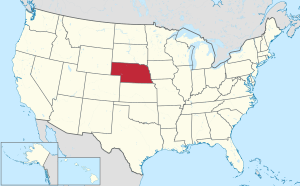Knox County, Nebraska
Knox County | |
|---|---|
 Knox County Courthouse in Center, Nebraska | |
 Location within the U.S. state of Nebraska | |
 Nebraska's location within the U.S. | |
| Coordinates: 42°38′N 97°53′W / 42.63°N 97.88°W | |
| Country | |
| State | |
| Founded | 1854 |
| Seat | Center |
| Largest city | Creighton |
| Area | |
• Total | 1,140 sq mi (3,000 km2) |
| • Land | 1,108 sq mi (2,870 km2) |
| • Water | 32 sq mi (80 km2) 2.77% |
| Population (2000) | |
• Total | 9,374 |
| • Density | 8/sq mi (3/km2) |
| Website | www |
Knox County is a county located in the U.S. state of Nebraska. As of 2000, the population was 9,374. Its county seat is Center.Template:GR
In the Nebraska license plate system, Knox County is represented by the prefix 12 (it had the twelfth-largest number of vehicles registered in the county when the license plate system was established in 1922).
Geography
According to the U.S. Census Bureau, the county has a total area of 1,140 square miles (2,952 km²), of which, 1,108 square miles (2,870 km²) of it is land and 32 square miles (82 km²) of it (2.77%) is water.Template:GR
Adjacent counties
- Bon Homme County, South Dakota - north
- Yankton County, South Dakota - northeast
- Cedar County, Nebraska - east
- Pierce County, Nebraska - southeast
- Antelope County, Nebraska - south
- Holt County, Nebraska - west
- Charles Mix County, South Dakota - northwest
- Boyd County, Nebraska - northwest
National protected area
History
The Lewis and Clark Expedition passed through the area on 4 September 1804.[citation needed]
The US Treaty with the Ponca tribe was signed at White Paint Creek on 9 June 1825.[citation needed]
Knox County was formed in 1854. It was named after Major General Henry Knox.[1]
Demographics
| Knox County Population by decade | |
|
1860 - 152 | |
As of the censusTemplate:GR of 2000, there were 9,374 people, 3,811 households, and 2,595 families residing in the county. The population density was 8 people per square mile (3/km²). There were 4,773 housing units at an average density of 4 per square mile (2/km²). The racial makeup of the county was 91.63% White, 0.09% Black or African American, 7.12% Native American, 0.16% Asian, 0.04% Pacific Islander, 0.34% from other races, and 0.63% from two or more races. 0.91% of the population were Hispanic or Latino of any race.
There were 3,811 households out of which 29.30% had children under the age of 18 living with them, 59.00% were married couples living together, 6.00% had a female householder with no husband present, and 31.90% were non-families. 29.90% of all households were made up of individuals and 17.40% had someone living alone who was 65 years of age or older. The average household size was 2.40 and the average family size was 2.98.
In the county the population was spread out with 25.50% under the age of 18, 5.50% from 18 to 24, 21.90% from 25 to 44, 23.90% from 45 to 64, and 23.10% who were 65 years of age or older. The median age was 43 years. For every 100 females there were 96.70 males. For every 100 females age 18 and over, there were 95.20 males.
The median income for a household in the county was $27,564, and the median income for a family was $34,073. Males had a median income of $23,373 versus $18,319 for females. The per capita income for the county was $13,971. About 12.50% of families and 15.60% of the population were below the poverty line, including 20.40% of those under age 18 and 13.50% of those age 65 or over.
Cities and villages
Townships
- Addison
- Bohemia
- Central
- Cleveland
- Columbia
- Creighton
- Dolphin
- Dowling
- Eastern
- Frankfort
- Harrison
- Herrick
- Hill
- Jefferson
- Lincoln
- Logan
- Miller
- Morton
- Niobrara
- North Frankfort
- Peoria
- Raymond
- Spade
- Sparta
- Union
- Valley
- Verdigre
- Walnut Grove
- Washington
- Western

